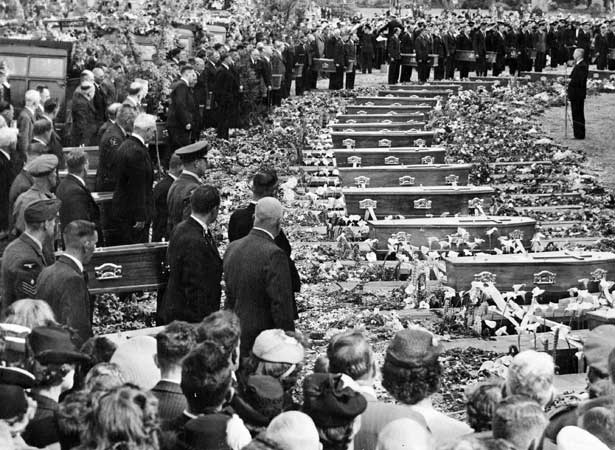
On 18 November 1947 Ballantynes, a Christchurch department store that was a local institution, was razed by the deadliest fire in New Zealand history.
The city was abuzz with visitors and shoppers following Cup Week and Show Day. In mid-afternoon, when the fire began, an estimated 250–300 people were shopping at Ballantynes, which had a staff of 458.
The store comprised eight buildings which were joined in ‘a perplexing maze’ by openings in the walls. The fire is thought to have started in a basement of the Congreves building. At about 3.35 p.m. staff member Percy Stringer saw smoke emerging from the stairwell to this basement. He went to check but on encountering fumes and hot smoke returned to the ground floor. He asked another staff member, Edith Drake, to alert the fire brigade and management to a ‘cellar fire’.
Stringer and other staff, including assistant manager Roger Ballantyne, tried in vain to put out the fire. As smoke began to drift into other parts of the ground floor, Ballantyne asked another staff member, Eric Boon, to call the fire brigade again. Though staff later confirmed witnessing an earlier call, Boon’s call at 3.46 p.m. was the first logged by the brigade. The 10-minute delay in placing the call, or in the brigade’s response, contributed to the tragic events that followed. By the time the brigade arrived at 3.48 p.m. – undermanned and ill-equipped to deal with anything larger than a fire in a cellar – the fire was already ‘surging out of control through all the horizontal and vertical vents and apertures’.
The ‘disturbing dimensions’ of the fire were not yet apparent to those on the ground floor. They believed the smoke, which by now was billowing from first-floor windows, was a result of a fire in a cellar that would be contained. No thought was given to a general evacuation of the building. Staff returning from a tea break were told to go back to work. Customers continued shopping and more entered the store – one as late at 3.56 p.m.
The initiative for an evacuation was eventually taken by individual staff members who cleared their areas of fellow staff and customers as the volume of smoke increased. Thanks in part to their efforts, all customers and most staff escaped unscathed. But the ‘millinery girls’ and those working in credit and accounts found themselves trapped. The loss of life amongst the company’s staff became clear when the survivors assembled at King Edward Barracks at 8 p.m. for a roll-call. Of the 49 staff who did not respond, 38 had perished in the fire. Violet Cody, pregnant with her first child, also died after jumping from the burning building. Two auditors from the firm Stewart, Beckett and Company also lost their lives.
A civic funeral was held for the victims on Sunday 23 November. Approximately 800 family and friends filled Christchurch Cathedral for the church service, with more gathered outside in the Square. The funeral procession was so long that by the time the last car left the Square, the first had arrived at Ruru Lawn Cemetery in Bromley, more than 4 km away. People lined the streets along the procession’s route and approximately 10,000 attended the graveside service.
A Commission of Inquiry into the fire found that Ballantynes and the fire brigade shared responsibility for the high loss of life. Ballantynes accepted its responsibility, but other businesses would probably have found themselves equally unprepared. The Commission’s recommendations proved to be a catalyst for change ‘in the way public buildings safeguarded staff and customers, and in the administration of the fire brigade’. When Ballantynes reopened on the same site in temporary premises in 1948, fire alarms were installed and a pamphlet on safety was issued to staff. The first rule – in bold type – described how to evacuate the premises in an emergency.
In 2005 Ballantynes celebrated its sesquicentenary (150th anniversary). Gordon Ogilvie, the author of a history commissioned to mark this milestone, commented that the company’s recovery following the fire was ‘one of the most remarkable stories in New Zealand’s commercial history’.
Like every business in central Christchurch, Ballantynes was hit hard by the earthquake of 22 February 2011. While some of its buildings were demolished, the company reopened on its City Mall site in time for Cup Week 2011. A concrete pour for the foundations of a temporary building in September was the first new construction work inside the ‘red zone’ since the February earthquake.
Read more on NZHistory
New Zealand disasters timeline – New Zealand disasters timelineBallantynes fire memorial – Memorials register
External links
How to cite this page
'Civic funeral for 41 Ballantynes fire victims', URL: https://nzhistory.govt.nz/a-civic-funeral-is-held-for-the-41-victims-of-the-ballantynes-department-store-fire, (Ministry for Culture and Heritage), updated 18-Nov-2022
